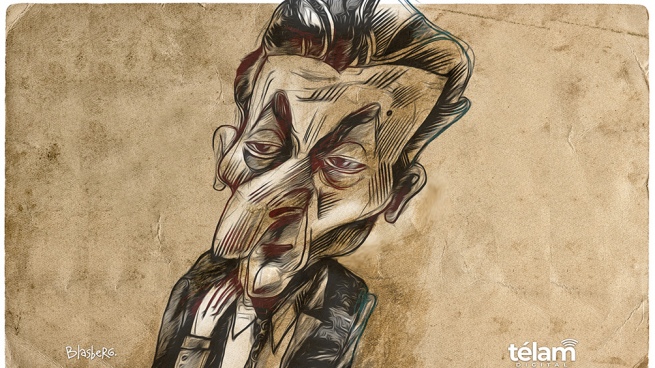This Thursday, December 23, they are 70 years of death from Enrique Santos Discépolo, creator of several of the most popular tangos such as “One”, “Cambalache” Y “Yira Yira”, and owner of a personal style to portray everyday life, the difficult love feelings and the society of his time, from a philosophical and committed perspective that transcends to this day.
“Discepolín” He was an actor, theater director, playwright, musician, film scriptwriter, composer, cultist of musical theater, conductor and creator of the character “Mordisquito”, epigraph of a social class ruled by appearances, that brought him so many problems with certain artists and intellectuals of that time, that they subjected him to all kinds of humiliations that ended up killing him with sadness at 50 years of age.
He was born in the Buenos Aires neighborhood of Once and his older brother was the playwright Armando Discépolo, who took charge of his education after the death of his parents -when he was just 11 years old-, and also who introduced him to the artistic world after Enrique confessed his interest in acting.
His first steps as a performer were taken in 1917 by integrating the cast of the play “Chueco Pintos”, of his brother and Rafael Jose de Rosa: the following year, he premiered his first own play at the National Theater, “The goblin”, written next to Mario Folco.
Before turning 20 I had already created the works “The priest” Y “Pass it on, corporal.” Already at that time, Enrique was beginning to feel love for tango, a musical genre that allowed him to make great friends such as Homero Manzi, Aníbal Troilo or Celedonio Flores, among other greats.
Perhaps influenced by his father Santo – an outstanding Neapolitan musician whose failure in Buenos Aires inspired Armando to create the central character of the grotesque “Stefano”– the thin young man with a fragile appearance began his path as a composer with the tango “Cake”, created 1924 at the request of the playwright Jose Antonio Saldías, which, however, passed without pain or glory.
In parallel to his theatrical life, which he developed both in Buenos Aires and Montevideo, he wrote tango lyrics that reflected the economic and social difficulties of his time, the 20s and 30s –those of the “infamous decade” -, from the melancholic irony and tenderness that characterized him.
Thus was born “What a crap”, in which one of its passages says: “What you need is to pack a lot of money, sell your soul, raffle your heart, throw away what little decency you have left … Silver, silver, silver and silver again … So it is possible that you morphe every day, have friends, a house, a name … and whatever you want ”.
“The hunger of others is something that always amuses those who have eaten”said Discepolín in a memorable scene from one of his films. The poet Julián Centeya he once hinted that as an actor he had “an air of Chaplin,” with good reason. A Creole and Porteño Chaplin.

Its first success came in 1928 from the hand of “I’m getting drunk tonight”, popularized by the female singer Azucena Maizani; From there, he began to have an important recognition in the universe of Buenos Aires music, and he met the woman with whom he shared almost a quarter of a century: the actress and singer Tania, a Spanish cupleist who carried the name of Ana Luciano Divis. and it gave him as many joys as the troubles that appear in his works.
Tania, cinema and politics
With Tania, undoubtedly the great love of his life, things were not easy: She brought her large Hispanic family into the relationship, tried to make Choly Mur a star, his daughter from a previous marriage, harassed him with her desire for riches and there is even talk of infidelities that over time are unverifiable.
Then the tango premiered “Jam”, Y Tita Merello made the aforementioned success a resounding success “What a crap”; Carlos Gardel also gave impetus to his career by recording several of his first tangos – in total he composed 50 -, among which his unforgettable version of “Yira, yira” stands out, in 1930.
He created tangos that are still valid as “Malevaje”, “I’m a harlequin” and the waltz “Dream of youth”, although his most popular songs were “Swap”, in 1934, “Alma de bandoneón”, in 1935 and “One” in 1943, with music by Mariano Mores.
As a film director, he had a medium impact and his films include “Four hearts” (1939), “Capricious and millionaire” (1940), “Candida, the woman of the year” (1943) and “The fan” (1951), his last film, directed by Manuel Romero, where he also plays the role of El Ñato, a soccer fan whose sentiments guide his impulses.
Militant of the national and popular camp, began to collaborate with the electoral campaign for the presidential re-election of Juan Domingo Perón in 1946, from the radio program “I think and say what I think”, through which figures such as Luis Sandrini and Tita Merello.
Later, with him, that space was called “Are you going to tell me?” and there he addressed a hypothetical interlocutor whom he baptized “Nibble”, which he adopted to represent the archetype of the anti-Peronist petty bourgeois that Arturo Jauretche later called “el medio pelo.”
During 1949, every night and on the National Broadcasting Network “Discepolín” he questioned the ethical and moral values of the time and thus cemented his popularity through a thought that was based on the crude description of a reality in crisis.
Peronism triumphed in the November 1951 elections, but the hatred of those sectors was cruel to the artist: his political opinions earned him the contempt of the intellectuals, who did not tolerate his dedication to the popular and turned their backs on him. They began to besiege him: he received threats, parcels that arrived with his records torn to shreds or with excrement, alterations of his own lyrics to humiliate him.
Some of his ex-friends exchanged a greeting for a spit on the floor when Discepolín appeared and They even organized a famous banquet at the El Tropezón restaurant, on Callao avenue, a meeting place for theater people after performances: the cutlery was all sold, but when Discepolín and Tania arrived, there was no one.
It was the beginning of the end: so attached to his affections, to that sensitivity that allowed him to devise characters with noble values and feelings, “Discepolín” decided not to suffer anymore, he allowed himself to die and did so on December 23, 1951.















